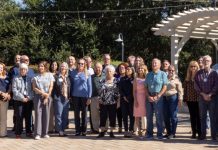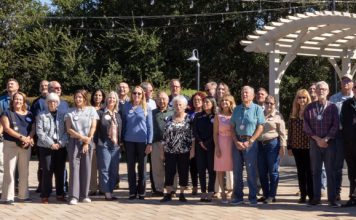SAN MARTIN
– Testing for perchlorate in local soils and foods and
distribution of bottled water were among the points discussed at a
perchlorate citizens’ advisory committee’s second meeting
Thursday.
SAN MARTIN – Testing for perchlorate in local soils and foods and distribution of bottled water were among the points discussed at a perchlorate citizens’ advisory committee’s second meeting Thursday.
A major theme at the cordial two-hour meeting held at San Martin’s Lions Club Hall was the need to find out whether local crops and soils contain perchlorate. Several community members on the committee stressed that testing for perchlorate in produce needs to happen soon – and preferably before some larger commercial crops from San Martin hit the shelves in June or July.
“We want to make sure, obviously, that a system is in place prior to that – those crops,” said Sylvia Hamilton, committee chairwoman and president of the San Martin Neighborhood Alliance. County Agricultural Commissioner Greg Van Wassenhove said it’s likely that residents will be able to get produce tested themselves long before the federal government conducts a risk assessment, which would provide more concrete interpretation of such data.
He said he’s working to identify a location where local produce can be tested before the time those crops would arrive in stores. Van Wassenhove’s initial discussions about private produce testing have centered on Texas Tech University – a leading researcher on perchlorate’s effect on plants – and Morgan Hill’s Sequoia Analytical Labs, which currently offers water testing here.
Some residents are making their own inquiries on the issue. For example, San Martin resident Sandy Petersen said she has asked Nob Hill Foods for information on the origin of its lettuce. A recent study commissioned by an environmental group found perchlorate in four of 22 lettuce samples taken from the shelves of Northern California supermarkets. That lettuce likely originated from Southern California or Arizona.
Van Wassenhove said lettuce that’s currently in local supermarkets likely originates from the Salinas Valley, while San Martin does not have commercially-grown lettuce that shows up in major area markets such as Albertson’s or Safeway.
“Right now, that lettuce you see at the stores is not perchlorate contaminated,” he said.
Larger local crops such as bell peppers are due around mid-summer, he said. While they could hit local markets, many are sold for processing.
Residents asked whether college or Silicon Valley corporate labs could be pressed into service. Van Wassenhove said Sequoia or Texas Tech will likely be faster and less expensive, although details about testing systems, cost, volume and confidentiality are still being worked out. Initial discussions with Texas Tech have hit upon around $150 a sample. Lists of other available private labs are also an option.
“We’re working on those details,” Van Wassenhove said. “We’ll get that (process) available as soon as we can.”
However, he also wondered how useful such raw data will be unless it has the proper interpretation, such as in a risk assessment that would consider factors such as dietary intake of different foods.
“It’s fine to have this data, but what does it mean?” he said. “That’s beyond me and this group.”
Meanwhile, residents stressed the importance of continued testing and bottled water distribution for homes whose wells may have tested non-detect for perchlorate but are surrounded by contaminated wells.
With some exceptions, officials said bottled water distribution has been tied to well testing to date. So far, any well that Olin tests is eligible for bottled water if it tests above 4 parts per billion, said Harvey Packard, an engineer with the Central Coast Regional Water Quality Control Board.
Petersen noted her well initially tested at 4.9 ppb by the water district but at 2.4 ppb the second time by Olin’s contractor. However, five nearby wells tested “dirty.”
And since perchlorate levels in wells can fluctuate with the rising or falling of the water table, a well that tests below 4 ppb isn’t necessarily going to be “fine,” Petersen said.
“I’m not about to have Olin say, ‘You’re not getting any more water, Mrs. Petersen,’ ” she said.
While Olin Corp. and officials are still working out the details, a resident whose well tests non-detect but is surrounded by contaminated wells will probably continue to receive bottled water, Packard said. Olin is working on plans for expanded testing outside the water district’s original testing area bordered by Tennant, Masten and Center avenues and Monterey Road, he said.
The committee also reviewed a flow chart of how the agencies should tackle the perchlorate response. So far it covers immediate, interim and long-term cleanup options and also effects on humans, animals and produce.
“I think we want a multifaceted approach and want something going on in all of these areas at all times,” Hamilton told officials.
Gilroy resident Sarah Brown asked officials to produce a timeline about when they will produce information and answers on different perchlorate issues.
“(It’s) so the community members can see there are plans in place to get them addressed,” she said. “There’s so much that seems to be unanswered at this point.”
Committee vice chairman and San Martin resident Bob Cerruti asked the water district to better document how it reached cost estimates for six different initial water treatment or distribution alternatives it has outlined to get non-bottled potable water to residents – and who will end up paying those costs.
A water district official is expected to make a presentation on that issue during the next meeting.
The advisory group includes citizens from South County communities and representatives of regulatory agencies and local elected officials. It was formed by the regional water board – the lead agency on the perchlorate cleanup – to advise agencies on and disseminate information about the South County perchlorate response.
Perchlorate is a by-product from the manufacture of flares, matches, fireworks and, in larger amounts, solid rocket fuel. A plume of the chemical has spread from an old Olin Corp. highway flare factory in Morgan Hill and contaminated several municipal wells in Morgan Hill, as well as hundreds of private wells south of the city.The Morgan Hill wells remain closed, although all but one are currently testing non-detect for the chemical.
According to the California Environmental Protection Agency, scientific studies have suggested perchlorate can disrupt thyroid hormone production. Inhibited thyroid function can result in hypothyroidism and in rare cases, thyroid tumors.













